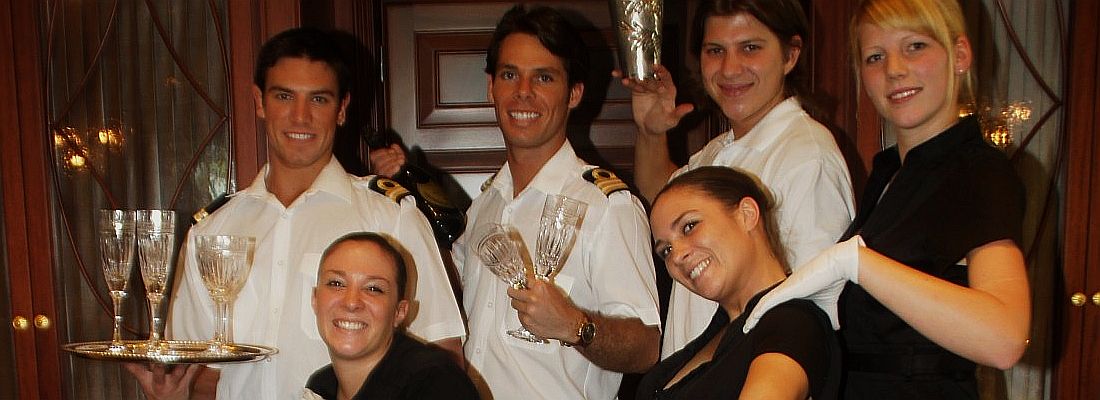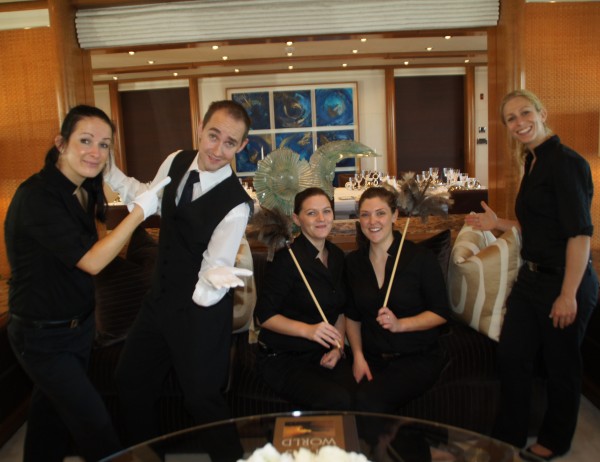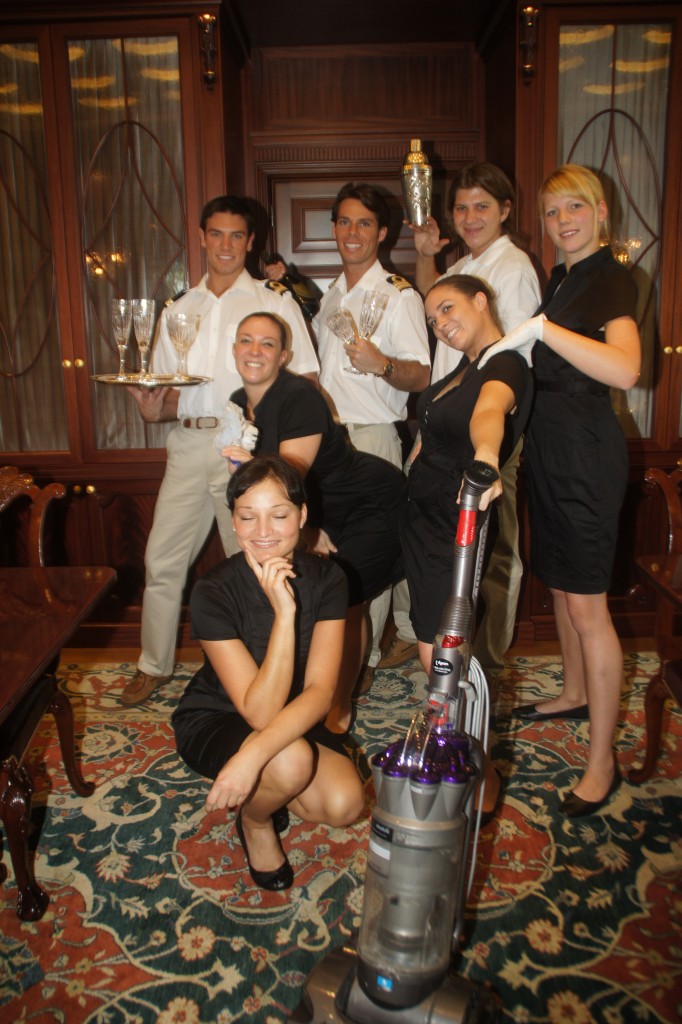“Julie from The Love Boat Ain’t Got Nothin’ on a Yacht Stew,” an excerpt from Chapter 4: Around the World with a Silver Tray — What Becoming a Yacht Stew Entails. This is a very detailed description of the duties performed by a superyacht steward/ess…
Julie From The Love Boat Ain’t Got Nothin’ on a Yacht Stew
To begin with, yacht stews are not like Julie from The Love Boat (being named Julie, you can only imagine how many times I heard that comparison), nor are they there to simply clean and serve. A yacht stew does perform those functions, but for a more appropriate comparison, think of the interior department’s role on one of these glamour vessels as equivalent to both managing and carrying out all of the tasks that go into running a five-star hotel—that floats.
For example, first consider all of the various functions performed in the daily operation of a hotel, and who is responsible for them. There are employees to clean rooms; employees to do laundry; employees to give information and to arrange for transportation; employees to assist guests at any time of the day or night; employees to serve food and employees to prepare drinks in the restaurants, at the pool, and for room service.
Next, take that same hotel and toss it out in the middle of the ocean as though it were a cruise ship, cut off from the conveniences of being on land and having a lot of outside resources at your disposal. You must now add in employees to entertain; employees to perform in medical emergencies; employees to handle safety issues; and employees to coordinate activities, both onboard and ashore.
Now, condense all of the employees from these previous examples down to two to four individuals who share all of those tasks and perform them for 12 or fewer high-maintenance guests. On luxury yachts, the ratio of crew-to-guests is a lot smaller, and therefore there is a lot more one-on-one attention that must be paid. And, mind you, at the end of what would be considered a normal “shift,” you cannot very well escape the guests you are there to serve.
When offering the ultimate in personal service, hard work and long hours are par for the course. The crew is there to fulfill the guest’s every whim. And the yacht stews—from the chief on down to the most entry-level—are expected to pull off everything I just described, along with the occasional help of the chef(s), perhaps a purser, and/or the exterior crewmembers.
Just for fun, let’s consider what different functions this means a stew could, quite possibly, be asked to perform in a day…
As a Yacht Stew, You Might Be Expected to Be a:
Housekeeper (an umbrella role for a variety of different functions—among them Duster, Vacuumer, Smudge Remover, Silver Polisher, Toilet Cleaner, and Chambermaid, which is just a more formal way of saying Bedmaker); Bartender; Cocktail Server; Meal Server or Waitress/Waiter (who can handle anything from setting up buffets to providing silver service, who knows the difference between tea service and coffee service, who is familiar with most rules of etiquette, and who can balance plates up his or her arm on a rocking boat while running up and down tiny staircases); Table Setter and Decorator; Napkin Folder; Gourmet-Food Expert; Hors d’oeuvres Preparer; Prep Cook; Food Garnisher; Plate Runner; Wine Expert/Sommelier (who can decant wine in rough seas without spilling a drop); Barista; Provisioner/Purchaser (of beverages, toiletries, linens, decorations, décor items, games, and other amenities, sometimes even the glassware, crockery, cutlery, and other items used for serving meals); Dish Washer; Flower Arranger; In-Cabin Service Attendant; Shoe Polisher; D.J.; Concierge; Tour Director; Laundry Person; Wardrobe Manager; Expert Stain Remover; Clothing and Linens Ironer; Social Director; Event and Party Planner; Interior Decorator; Nanny; Public Relations Specialist; Personal Assistant/Shopper; Errand Runner; Stylist; Hotel Manager and Customer Service Representative; Porter or Bell Hop; Inventory Taker; Nurse; Accountant; Psychologist; Marriage Counselor; Butler; Negotiator; Diplomat; occasional Deckhand; Office Assistant; Crew “Parent”; and Fill-in Monopoly Player. Some stews even have their masseuse licenses and can offer massages to the guests (or reflexology, or yoga instruction, or manicures)… Heck, why not even come prepared with a set of tarot cards?
That’s a lot of hats you must be prepared to wear, accompanied by a smile on your face, a bounce in your step, and a “Can Do!” attitude. (How appropriate that stew—as in the kind we eat—is a “combination of ingredients thrown together.”)
In fact, the entire crew, as a whole, is expected to be ready for anything and to handle all requests, no matter how demanding or off-the-wall. A popular crew reminder given by one of my former captains just before the guests arrived: “Remember, there are no problems, only solutions.”
Guests Onboard vs. No Guests Onboard
There is a big difference in a stew’s daily routine when there are guests on-board vs. when there are no guests on-board. With guests, the crew is in service mode. This is when the workload is toughest on the interior staff. The hours can be grueling, and a stewardess must be available at all times—from dawn until the wee hours of the morning (depending on when the guests retire). Members of the stew department must be organized and prepared to provide effortless service throughout the trip, no matter what mishaps occur behind the scenes. But remember, this is a team effort. (No stew is an island, unless he or she is working on a small yacht, under 100 feet!)
The daily responsibilities are much different when there are no guests on-board. Then, the job is more about maintaining the yacht and cleaning and preparing for the next group of guests. The hours during these guest-free periods will more closely resemble those of a regular land job: 8 a.m. to 5 p.m., with either a half-day on Saturday, or the entire weekend off. The exception to those work hours would be if the crew is pressed for time between trips. Heavily booked charter yachts are known for having only a two- or three-day turn-around between sets of guests, which requires longer days (hence, the big tips you get on charter boats). On the other hand, some private yachts and chartered vessels can go weeks or months with no guests.
Other scenarios with no guests on-board are when the yacht goes into the shipyard for repairs or undertakes a long journey to relocate, such as a transatlantic crossing. Then, the lion’s share of the work falls onto the exterior and engineering departments, giving the stews a bit of a break (and the deckhands a reason to complain).





